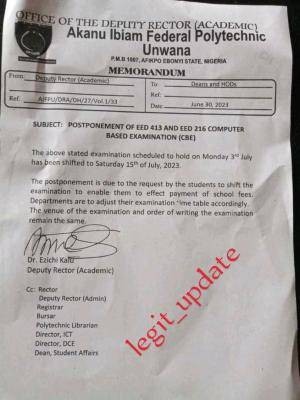
All over the world, education is considered as a human right that should be accorded. It is the reason why many international human rights bodies consider education a fundamental human right. Given the central importance of formal education, it soon became the largest social programme of the three tiers of government.
However, over the years, Nigeria’s educational sector has experienced a lot of rot which has also contributed to students’ performance. One can therefore imagine what the future holds for this very important sector of the nation’s economy.
The poor performance in external examinations, especially in Secondary Schools Certificate Examination (SSCE) and the General Certificate of Education (GCE) examinations by students, has become a source of worry to stakeholders in the education sector, especially in view of the nation’s goal to be one of the world’s top 20 economies by 2020. Recent statistics released by the two examination bodies show that the standard of teaching and learning in schools have continued to wane at an alarming rate.
The poor performance of students in WAEC and NECO exams in recent times, has resulted in an average failure rate of 72 per cent, 74 per cent, 74 per cent and 75 per cent in 2008,2009, 2010 and 2011 respectively.
Similarly, the May/June SSCE 2010/2011 examination results show that only 451,187 candidates of 1,351,557 who sat for the exam obtained credit in English Language while 560,974 obtained credit in Mathematics.
The results of 77,168 candidates who sat for the exam were withheld for their alleged involvement in examination malpractice. While NECO 2010 reveals that a total of 1,143,169 candidates registered for the examination, 1,132,357 actually sat for the examination. A breakdown of the results shows that only 244,456 candidates passed English Language at credit level while 279,974 passed Mathematics.
Similar Posts:
The Registrar and Chief Executive of NECO, Professor Promise Okpala, who exonerated the examination bodies of the mass failure, blamed it on the quality of teaching in schools, saying unless there is improvement in teaching and learning in schools, there is little the examination bodies could do to salvage the already bad situation.
According to him, less than average of 30 per cent out of the candidates passed at credit levels in the two core subjects — Mathematics and English Language — for the past five years. The Minister of Education, Chief Nyesom Wike, equally expressed displeasure at the students’ poor performance, noting that less than 30 per cent of over a million students, who sat for the examinations within the last six years, obtained credits in five subjects, including English Language and Mathematics.
Toying with the jewel:
Many have described the rot in the education system as toying with the nation’s priceless jewel. “Education is everything; the jugular vein of any nation is the education sector. Once the sector collapses, the collapse of the entire system is imminent,” said an economist. He blamed the all-pervading system failure across all sectors on the failure of the education system. “The ill-educated engineers construct bad roads. Likewise, the ill-educated medical doctors are not doing well in the health sector,” he said.
The Solution:
Speaking at the presentation of Project 3600 held in Ikeja, Project Manager for E2DMC, Mrs Olatunji Olajumoke said, “There has been a lot of buck-passing on who is to blame on the falling education standard; the Government, school system, parents or even the student.”
According to her, amongst other causes, a major factor attributed to students’ poor performance is the lack of conducive teaching and learning environment, no knowledge of our children’s specific learning difficulties, inadequate or non-existent teaching aids and lack of infrastructure.”
Olatunji maintained that the key to educational success lies in student assessments in English Language and Mathematics, which is the concrete on which education is built. She said: “In the United Kingdom and United States, students are assessed for their specific strengths and weaknesses twice a year, allowing educators to identify if a student will fail before they fail. Student assessment software such as The Profiler, can provide the much needed support in education by providing not only the assessment but step by step instructions for the teacher to address the student’s specific learning difficulty.”
The GIS specialist with vast experience in Project Management disclosed that E2DMC (Education Electronic Data Marketing Company) is the first data-driven educational marketing company in West Africa. According to her, E2DMC’s goal is to intelligently use technology to position education for global competitiveness as it opens up vast opportunities accessible in Nigeria and its growing network of emerging economies in Africa.
Her words: “Our core business model is to bridge the huge gap between education products/service providers and a growing market of educational institutions.”
Worried by the wane in the sector and the need to salvage a seemingly bad situation, Project 3600 was initiated. “A project designed to set up a minimum of 100 Talent/Learning Centres per state and it’s a platform with the objective of encouraging students to learn in dynamic and interesting ways and increase their knowledge of basic subjects i.e. Mathematics, English and Basic Science, particularly amongst the less privileged students in public schools where the impact would be greatly felt.
““The idea is to have school-”friendly organisations sponsor learning centres for learning at very subsidised rates with various brand visibility and consumer engagement opportunities.”



